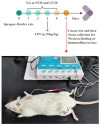Electroacupuncture Alleviates Neuroinflammation by Inhibiting the HMGB1 Signaling Pathway in Rats with Sepsis-Associated Encephalopathy
- PMID: 36552192
- PMCID: PMC9776077
- DOI: 10.3390/brainsci12121732
Electroacupuncture Alleviates Neuroinflammation by Inhibiting the HMGB1 Signaling Pathway in Rats with Sepsis-Associated Encephalopathy
Abstract
Sepsis-Associated Encephalopathy (SAE) is common in sepsis patients, with high mortality rates. It is believed that neuroinflammation is an important mechanism involved in SAE. High mobility group box 1 protein (HMGB1), as a late pro-inflammatory factor, is significantly increased during sepsis in different brain regions, including the hippocampus. HMGB1 causes neuroinflammation and cognitive impairment through direct binding to advanced glycation end products (RAGE) and Toll-like receptor 4 (TLR4). Electroacupuncture (EA) at Baihui (GV20) and Zusanli (ST36) is beneficial for neurological diseases and experimental sepsis. Our study used EA to treat SAE induced by lipopolysaccharide (LPS) in male Sprague-Dawley rats. The Y maze test was performed to assess working memory. Immunofluorescence (IF) and Western blotting (WB) were used to determine neuroinflammation and the HMGB1 signaling pathway. Results showed that EA could improve working memory impairment in rats with SAE. EA alleviated neuroinflammation by downregulating the hippocampus's HMGB1/TLR4 and HMGB1/RAGE signaling, reducing the levels of pro-inflammatory factors, and relieving microglial and astrocyte activation. However, EA did not affect the tight junctions' expression of the blood-brain barrier (BBB) in the hippocampus.
Keywords: HMGB1; electroacupuncture; neuroinflammation; sepsis-associated encephalopathy.
Conflict of interest statement
The authors declare no conflict of interest.
Figures









Similar articles
-
Electroacupuncture Improves Blood-Brain Barrier and Hippocampal Neuroinflammation in SAMP8 Mice by Inhibiting HMGB1/TLR4 and RAGE/NADPH Signaling Pathways.Chin J Integr Med. 2023 May;29(5):448-458. doi: 10.1007/s11655-023-3592-5. Epub 2023 Jan 7. Chin J Integr Med. 2023. PMID: 36609953
-
HMGB1 augments cognitive impairment in sepsis-associated encephalopathy by binding to MD-2 and promoting NLRP3-induced neuroinflammation.Psychogeriatrics. 2022 Mar;22(2):167-179. doi: 10.1111/psyg.12794. Epub 2021 Dec 21. Psychogeriatrics. 2022. PMID: 34931753
-
HMGB1 mediates synaptic loss and cognitive impairment in an animal model of sepsis-associated encephalopathy.J Neuroinflammation. 2023 Mar 11;20(1):69. doi: 10.1186/s12974-023-02756-3. J Neuroinflammation. 2023. PMID: 36906561 Free PMC article.
-
High Mobility Group Box 1 (HMGB1): Potential Target in Sepsis-Associated Encephalopathy.Cells. 2023 Apr 4;12(7):1088. doi: 10.3390/cells12071088. Cells. 2023. PMID: 37048161 Free PMC article. Review.
-
Impact of HMGB1, RAGE, and TLR4 in Alzheimer's Disease (AD): From Risk Factors to Therapeutic Targeting.Cells. 2020 Feb 7;9(2):383. doi: 10.3390/cells9020383. Cells. 2020. PMID: 32046119 Free PMC article. Review.
Cited by
-
Pasteurized akkermansia muciniphila improves irritable bowel syndrome-like symptoms and related behavioral disorders in mice.Gut Microbes. 2024 Jan-Dec;16(1):2298026. doi: 10.1080/19490976.2023.2298026. Epub 2024 Jan 3. Gut Microbes. 2024. PMID: 38170633 Free PMC article.
-
The Biological Changes of Synaptic Plasticity in the Pathological Process of Sepsis-associated Encephalopathy.Curr Neuropharmacol. 2025;23(4):359-374. doi: 10.2174/1570159X23666241028105746. Curr Neuropharmacol. 2025. PMID: 39473252 Free PMC article. Review.
-
Electroacupuncture suppresses neuronal ferroptosis to relieve chronic neuropathic pain.J Cell Mol Med. 2024 Apr;28(7):e18240. doi: 10.1111/jcmm.18240. J Cell Mol Med. 2024. PMID: 38509741 Free PMC article.
-
Electroacupuncture inhibits the expression of HMGB1/RAGE and alleviates injury to the primary motor cortex in rats with cerebral ischemia.Transl Neurosci. 2023 Oct 9;14(1):20220316. doi: 10.1515/tnsci-2022-0316. eCollection 2023 Jan 1. Transl Neurosci. 2023. PMID: 37829255 Free PMC article.
-
Protective Role of Electroacupuncture Against Cognitive Impairment in Neurological Diseases.Curr Neuropharmacol. 2025;23(2):145-171. doi: 10.2174/1570159X22999240209102116. Curr Neuropharmacol. 2025. PMID: 38379403 Free PMC article. Review.
References
-
- Singer M., Deutschman C.S., Seymour C.W., Shankar-Hari M., Annane D., Bauer M., Bellomo R., Bernard G.R., Chiche J.D., Coopersmith C.M., et al. The Third International Consensus Definitions for Sepsis and Septic Shock (Sepsis-3) JAMA. 2016;315:801–810. doi: 10.1001/jama.2016.0287. - DOI - PMC - PubMed
-
- Zhao L., An R., Yang Y., Yang X., Liu H., Yue L., Li X., Lin Y., Reiter R.J., Qu Y. Melatonin alleviates brain injury in mice subjected to cecal ligation and puncture via attenuating inflammation, apoptosis, and oxidative stress: The role of SIRT1 signaling. J. Pineal Res. 2015;59:230–239. doi: 10.1111/jpi.12254. - DOI - PubMed
Grants and funding
LinkOut - more resources
Full Text Sources
Miscellaneous

